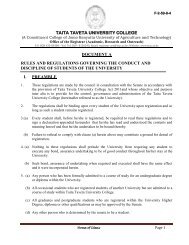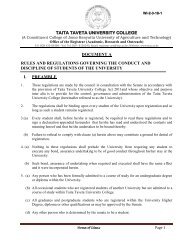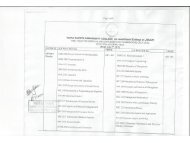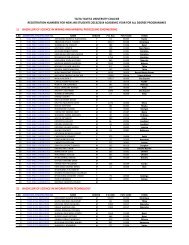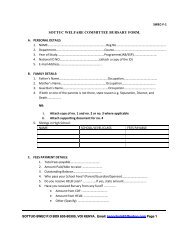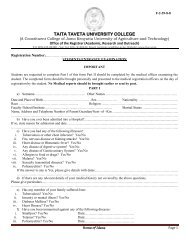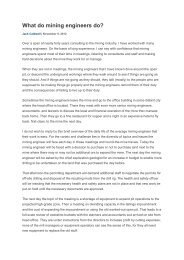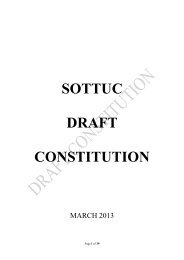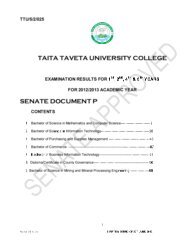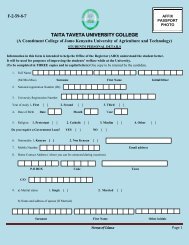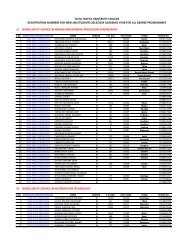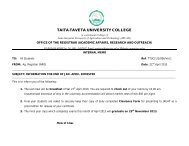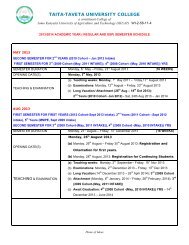Conference Book of Abstracts - Taita Taveta University College
Conference Book of Abstracts - Taita Taveta University College
Conference Book of Abstracts - Taita Taveta University College
- No tags were found...
Create successful ePaper yourself
Turn your PDF publications into a flip-book with our unique Google optimized e-Paper software.
ased study <strong>of</strong> archaeal community structure in various higher termites, including wood-feeding,soil-feeding, and fungus-cultivating species. Highest diversity <strong>of</strong> methanogens was observed inthe soil feeders, where representatives <strong>of</strong> almost all major lineages were present, including aclade <strong>of</strong> uncultivated archaea distantly related to the Thermoplasmatales, which represent anovel lineage <strong>of</strong> methanoarchaea (K. Paul, J. Nonoh, and A. Brune, in preparation). The densityand distribution <strong>of</strong> archaea in the different termites and gut compartments was compared byqPCR analysis. Experimental stimulation <strong>of</strong> methanogenesis in gut homogenates <strong>of</strong> Cubitermesugandensis indicated that community structure in the different compartments microenvironmentsis shaped by exogenous factors, such as oxygen status and the availability <strong>of</strong>methanogenic substrates.Assessment <strong>of</strong> Sedimentation <strong>of</strong> Masinga Reservoir and its Implication on the Capacity <strong>of</strong>the Dam for Hydropower GenerationBunyasi, Muzungu Martin¹ and Onywere, Simon Mang’erere²¹ ²Department <strong>of</strong> Environmental Planning and Management, Kenyatta <strong>University</strong>, KenyaContact email: martinsembie@gmail.comMasinga Dam was commissioned in 1981 and has a full operation surface area <strong>of</strong> about 125 km 2that extends about 45 Km upstream. The Dam is the largest <strong>of</strong> the Seven Forks Hydro ElectricPower (HEP) project dams with a design capacity <strong>of</strong> 1,560 million m 3 . Masinga catchment ispart <strong>of</strong> the Tana River basin and covers an area <strong>of</strong> about 6,255 Km 2 traversing 9 countiesnamely; Murang‟a, Nyandarua, Kirinyaga, Kiambu, Laikipia, Machakos, Kitui, Nyeri and Embu.The Dam has installed capacity <strong>of</strong> 40 MW and also plays the role <strong>of</strong> regulating water flow intosubsequent dams and controlling downstream flooding. Masinga Dam therefore directly affectsthe seven forks hydropower project with about 55% <strong>of</strong> Kenya‟s generated energy. The Dam isthreatened by loss <strong>of</strong> water storage capacity due to increased dam sedimentation which is linkedto the watershed agriculture activities and land use patterns, river characteristics, and reservoirlocation and design. Rapid human population increase in the region at a rate <strong>of</strong> about 13.6%between 1969 and 2009, has led to increased catchment settlement and farming on steep slopeswithin the catchment, leading to rapid soil erosion. The dam‟s high trap rate <strong>of</strong> up to 98%yielded about 23 million m 3 loss <strong>of</strong> water storage volume annually in its initial years. By 1988about 6% (93.9 million m 3 ) <strong>of</strong> the dam‟s storage capacity had been lost due to sedimentationresulting in rapid loss <strong>of</strong> a stable hydraulic head. This raised concerns on HEP capacity <strong>of</strong> theTana hydro-dams. To develop an effective catchment management strategy to improve the dam‟ssedimentation regime, this research assessed how Masinga catchment activities have affectedMasinga Dam‟s storage capacity and hydropower generation. The study assessed the level andtrend <strong>of</strong> sedimentation <strong>of</strong> Masinga Reservoir and the relationship between Masinga catchmentvegetation cover change and sediment loading into Masinga Dam. The study also determined thecorrelation between Masinga Catchment precipitation and temperature trends, and Masinga daminflows and sediment loading and its effects on hydropower generation capacity. The dataanalysis methods utilized included the Normalized Difference Vegetation Index (NDVI) usingArcGIS 10.0 and ERDAS IMAGINE 9.1, statistical analysis using SPSS s<strong>of</strong>tware for correlationanalysis, and descriptive and inferential statistics. The research findings indicated that thecatchment temperate is rising by 0.02 0 C annually, the rains are declining by 3.9 mm annually,Masinga reservoir inflow is dropping by 0.74 cumecs annually, catchment forest is shrinking by



